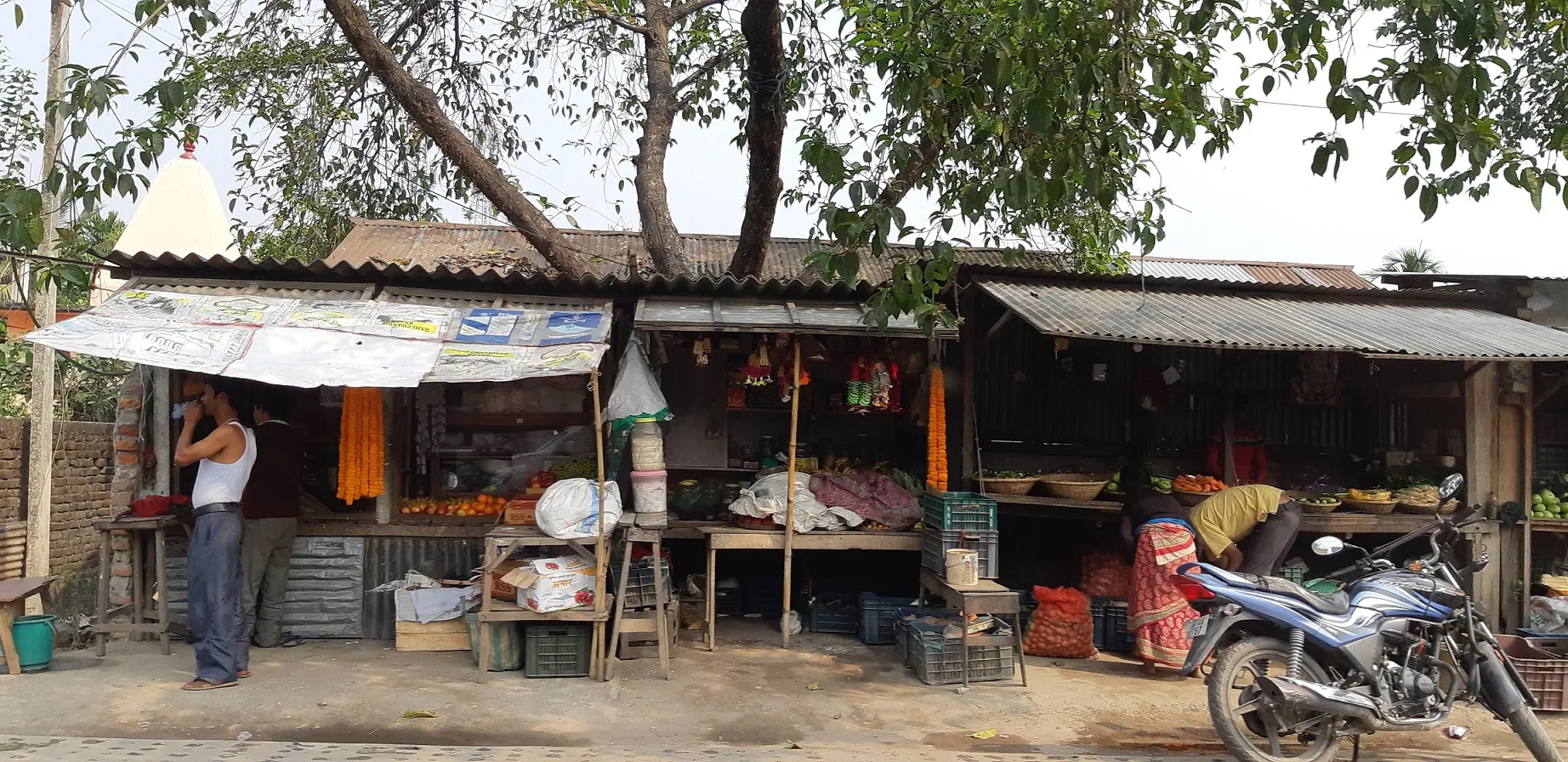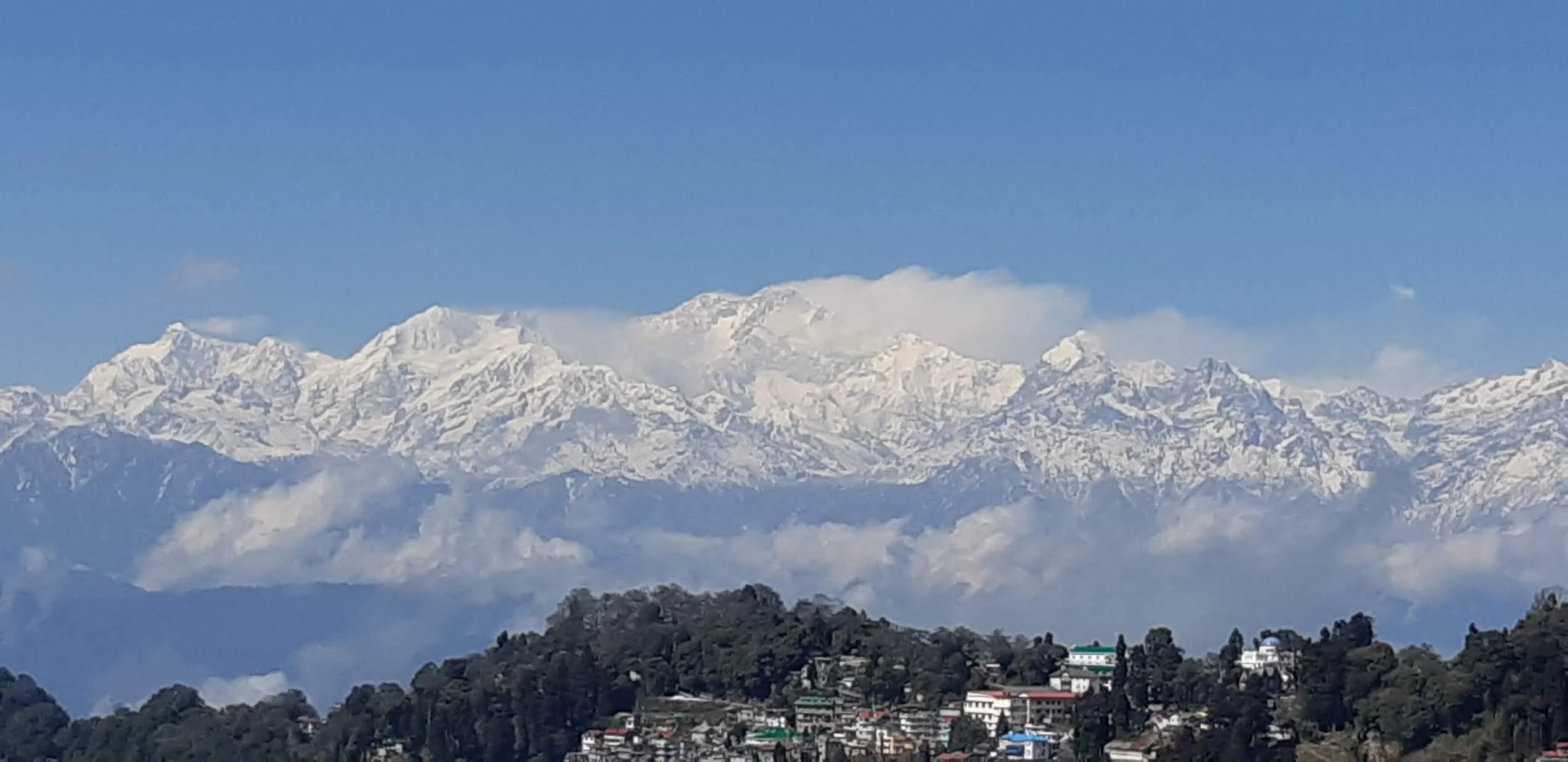Leaving Kaziranga National Park in north-eastern India, we flew to Bagdogra. We were heading there because Bagdogra has the airport closest to Darjeeling, our next sightseeing destination.
 |
| Bagdogra roadside stalls |
We travelled in a taxi from the airport to our accommodation in Bagdogra, passing a lot of dusty roadside stalls, and busy street markets on the way.
Arriving at our hotel, the Jagat, we found it was very strangely located almost under a new motorway, and down a little alley, in a roughish looking area.
Initially, we were a little sceptical of the place because of its location and appearance from both the outside and inside.
 |
| Street seller with chickens in baskets, Bagdogra |
Outside was full of roadworks, dust, men, and street sellers. Inside, the foyer was bare but our room clean, the men friendly (no women to be seen), and we were able to get some decent food in their restaurant for our evening meal.
We wanted to travel up into the hills of Darjeeling the next day, so instead of trying to find another taxi, we managed to negotiate a good price with the taxi driver who drove us from the airport.
The next morning, he arrived on time and we headed off.
The drive up the mountain was on an incredibly narrow and winding road, full of switchbacks.
 |
| Narrow winding road to Darjeeling |
It was so narrow that vehicles going one way had to regularly pull over to let vehicles going the other way get past. It was an interesting 3-hour drive, but definitely a trip to test the nerves!
We passed houses and shops that appeared to be precariously perched on the sides of hills, with rather large drop-offs in some places.
 |
| Village in the shadow of the hills near Darjeeling |
We drove through several small villages, some bright and full of colour in the sun, and others looking grim and grubby, sitting in the shadow of the mountains.
Darjeeling is in the foothills of the Himalayas, and is often referred to as the 'Queen of the Hills'. So, as you can imagine, the streets are hilly and quite steep.
Arriving in Darjeeling township, our taxi driver wound his way up through the narrow, steep and congested streets with gay abandon.
After much beeping of horns, we eventually reached a corner where our driver informed us he could go no further. He pointed to indicate that our hotel was five minutes in “that” direction – “that” being upwards.
We had to drag our cases up a narrow steep street that was half dug up, with only a little sliver of pavement left. On the bright side - no cars were allowed, so no beeping! We passed lots of shops with people milling everywhere.
At this stage, the coldness in the air was really getting to us so we stopped to put on our rain jackets. This helped a little, but boy it was cold.
 |
| Darjeeling, Queen of the Hills |
After at least another five minutes of slogging upwards, we found our hotel, the Classic Guesthouse. It is in a quaint looking building in a very narrow lane, perched on the side of the hill.
We were glad to enter and get out of the cold, and were made to feel very welcome by the friendly owner. After being shown our room, we were soon unpacked.
Darjeeling sits at an altitude of just over 2,000 metres. It's still winter here with lots of low cloud, but we had a spectacular, albeit misty, view over the hills from our room.
Having come from higher temperatures and having very little warm gear with us, our first task in Darjeeling was to find warmer clothes.
We found some really warm hats at the nearby market, then walking further along the main street, we found a shop that sells jackets. After some haggling, we purchased two 'designer brand' puffer jackets at bargain prices. Ah bliss, we finally started to feel warmer. The hotel meanwhile, organised a heater for our room, which also helped.
 |
| Darjeeling |
The next day, we explored the town along its busy, winding, and narrow roads, which zig-zag up and around the mountain-side.
As we got higher, the roads narrowed to pedestrian-only streets, and the whole lot was crisscrossed by narrow alleyways creating shortcuts between the streets and roads. Great fun to explore.
There are heaps of tiny little shops and restaurants, and a few slightly bigger ones. We spotted a Subway and a Kentucky Fried. Not sure if that is good progress!
 |
| Darjeeling |
The people here are very friendly. Many look quite different to the people we have seen in other parts of India and appear more Nepalese. They dress quite differently too. They speak Nepali and Hindi, and quite a lot speak English.
The next morning, wrapped up in our new warm gear, we went down to the railway station to have a trip on the Darjeeling Himalayan Railway Toy Train.
 |
| Toy Train (UNESCO) |
Built between 1879 and 1881, it is a cute little steam train that runs on a very narrow-gauge rail. It covers around 88 km between the lower lying city of New Jalpaiguri and Darjeeling, using six zig-zags and five loops to gain altitude. It is a UNESCO World Heritage train.
We did the trip from Darjeeling to Ghoom and back. Ghoom is India’s highest railway station. It was a very interesting and scenic ride.
The railway track is fascinating in that it runs right beside the road, and every so often it crosses over to the other side. Traffic waits while it passes through – no bells, lights or boom gates as in our country.
 |
| Houses so close to the train track |
We were amazed at how close the houses were built to the railway line. From the train windows, you could just about pick flowers from pot plants on window sills, or grab someone’s washing off the clothesline as you went past.
We had a great morning on this wonderful little train.
That afternoon we walked to the Happy Valley Tea Plantation to learn more about the famous Darjeeling tea. It is often called the 'Champagne of tea', because it is not produced anywhere else in the world, just as with wine in the Champagne region of France.
 |
| Tea plantation |
Darjeeling tea plants are unique because the leaves can be processed in a way that gives black, white, green or oolong tea.
Being colder weather when we were there, the tea was not being picked. However, we got to see the machines and have the process explained to us, then we had an interesting tea tasting. We enjoyed it.
We had walked down a long and very steep road to get to the plantation, and were a bit concerned about the walk back up again, to return to our hotel.
Luckily, we discovered they had a free taxi service back to town, that we shared with a very talkative Irish man and a quiet Korean.
Tea plants grow everywhere in the Darjeeling area, up and down steep hills and on the flat. Some of them must be a real challenge to pick.
There are also a lot of rhododendrons and magnolias reminding us of home.
Apart from being cold here it has been very misty and foggy, preventing us from viewing the Himalayan Mountains we had hoped to see. We were looking for Kanchenjunga, the highest mountain in India and the third highest in the world. They say you can even see Everest from here sometimes, but it was not to be for us, as the fog was too thick.
After a few days, it was time to leave Darjeeling. We had to drive back down the winding road to Bagdogra to catch a plane to our next destination.
But then, just as we were driving out of Darjeeling, the clouds cleared and we were treated to the most incredible view of Mt Kanchenjunga!
What a spectacular sight - it made our day!
We happily carried on to the airport satisfied that we had seen all we had aimed to see in Darjeeling. Now we are looking forward to our next stop, which is Kolkata.
The above blog is part of our 2-month tour of India. The first blog on this tour is called "Off to Delhi".




